Surprise, leakers: the Series 7 Apple Watch has no wild new design with flat sides. Instead, it’s the kind of release that teardowns are made for: full of secrets that only a trained eye can spot, that only an Apple engineer could fully explain.
Fortunately, this time we brought both.
We rang up our friends at Instrumental, a crack team stacked with former Apple engineers—several of whom led development on early Apple Watch designs. You might say they were instrumental in its creation.
Inside we found some surprising display technology that was probably a huge pain to manufacture at scale, likely causing a cascade of delays. When Apple finally unveiled it last month, the watch had no firm release date, a red flag that usually signals production trouble. (If you’re wondering how a bunch of ex-Apple engineers occupy their time nowadays, read on—this is exactly the kind of expensive manufacturing snafu they’ve banded together to solve.)
Once More Unto the Watch
As always, the first order of business is getting inside, and the larger Series 7 displays helped us out a little here. For the first time, our standard suction handle can maintain a grip on the screen, allowing you to lift it, carefully, until there’s room enough to slide a pick underneath the bezel. You just need to heat the display first to soften the adhesive; we grilled ours face-down on a heating mat at 80° C.

While they simmered, we huddled with Creative Electron for the usual X-ray treatment. (Compare last year’s X-ray from our Series 6 teardown.)

After that, all we had to do was get a pick in, pry it up, and not catch or stretch anything inside this brand-new device by accident. And we did fine! (It’s nice when you can look like you know what you’re doing while the original Apple Watch architects peek over your shoulder—no pressure.)
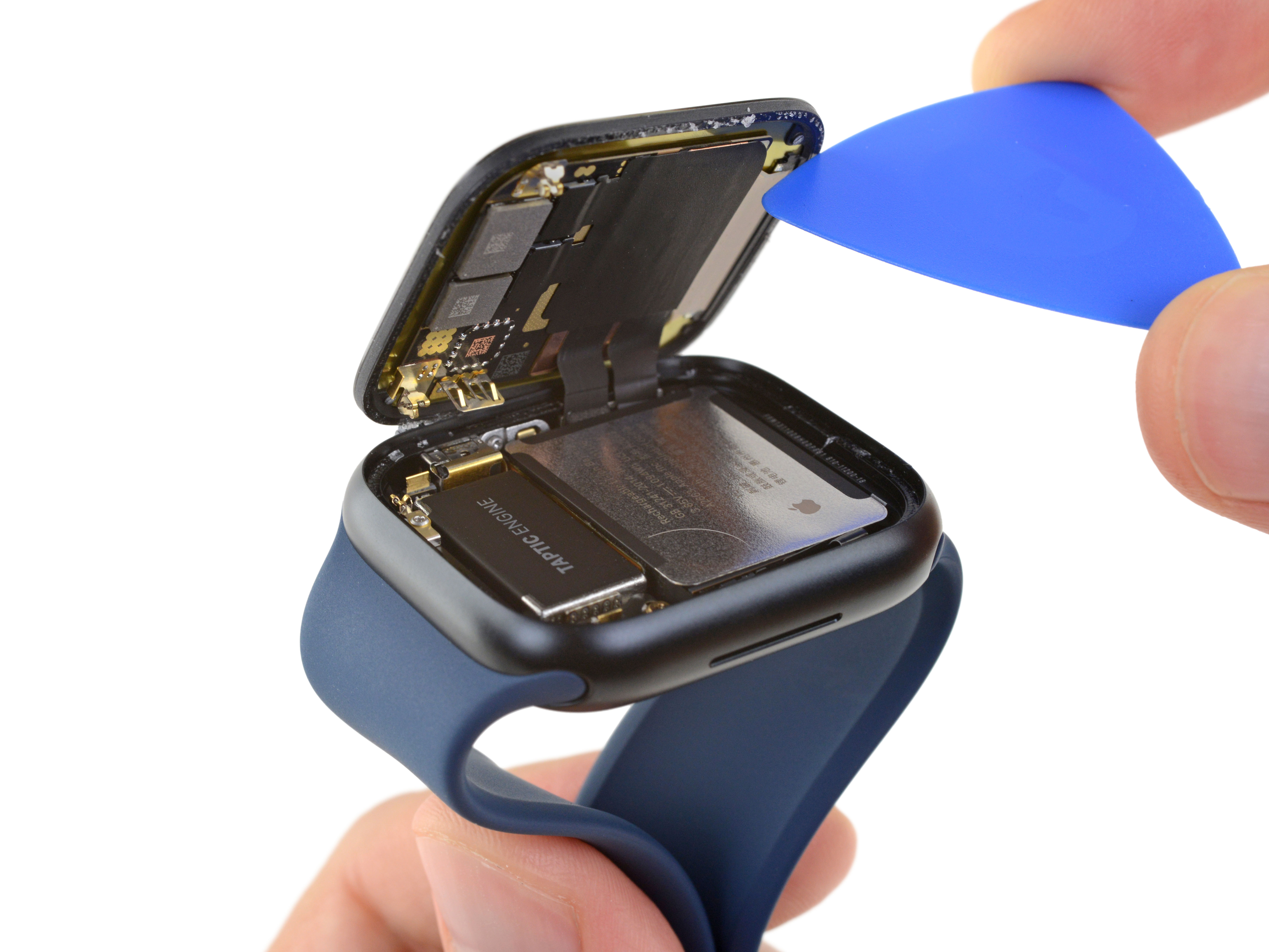
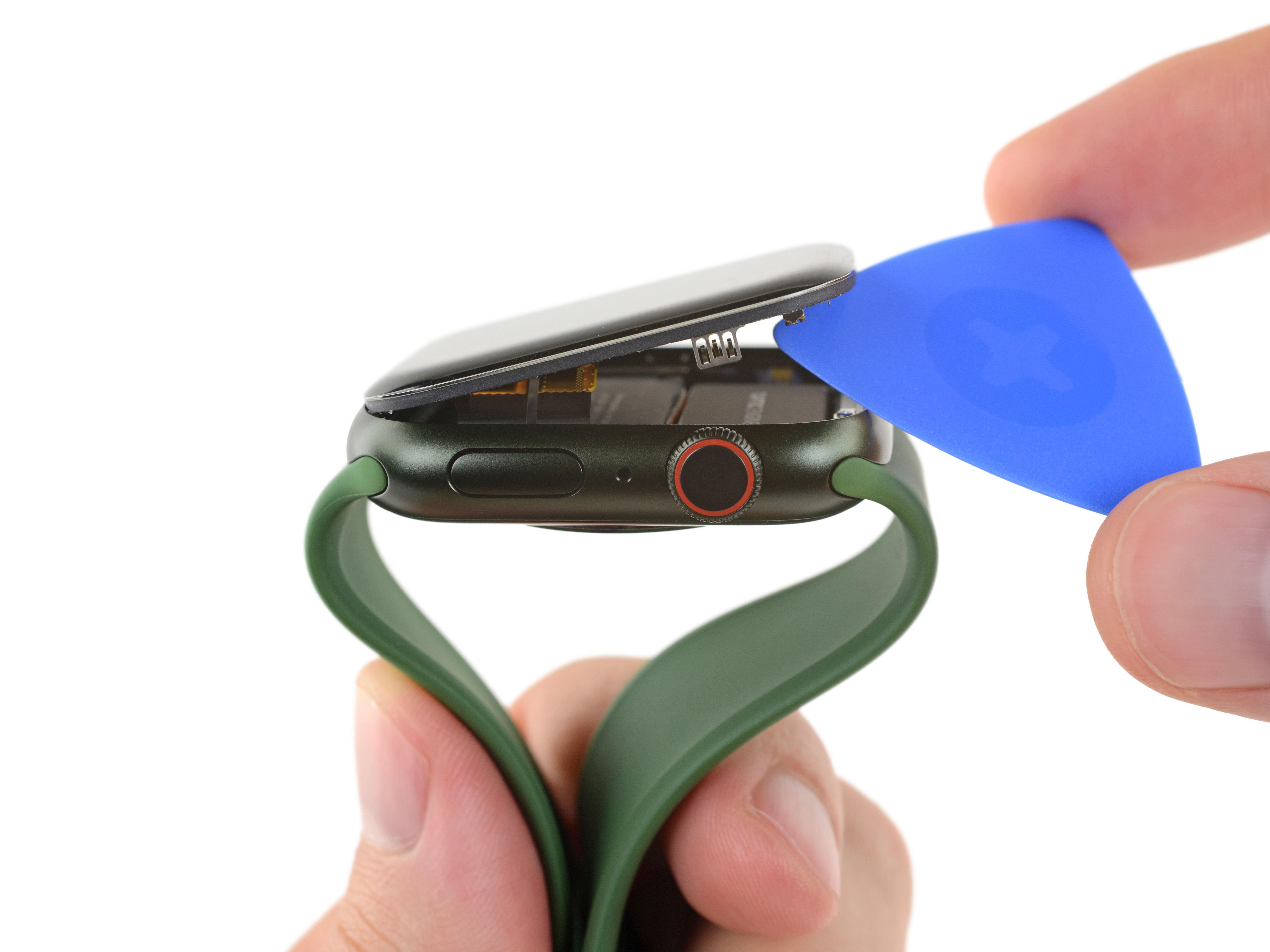
Displays and Delays

Inside, the changes are subtle, but significant. Right off the bat, longtime Watch-watchers will note the Series 7 is missing the fiddly bracket underneath the battery where the diagnostic port once lived. Rumor has it that Apple now uses a high-frequency wireless interface instead. More on this later.

The changes to the displays are much less subtle. The Series 7 display, despite being new and improved, looks less complex at first glance. The familiar Series 6 display had two prominent flex cable folds—one dressed in black at the top, for the touch sensor layer, and a second dressed in drab green at the bottom, for the OLED panel itself. But the Series 7 somehow gets away with just one flex, at the bottom.
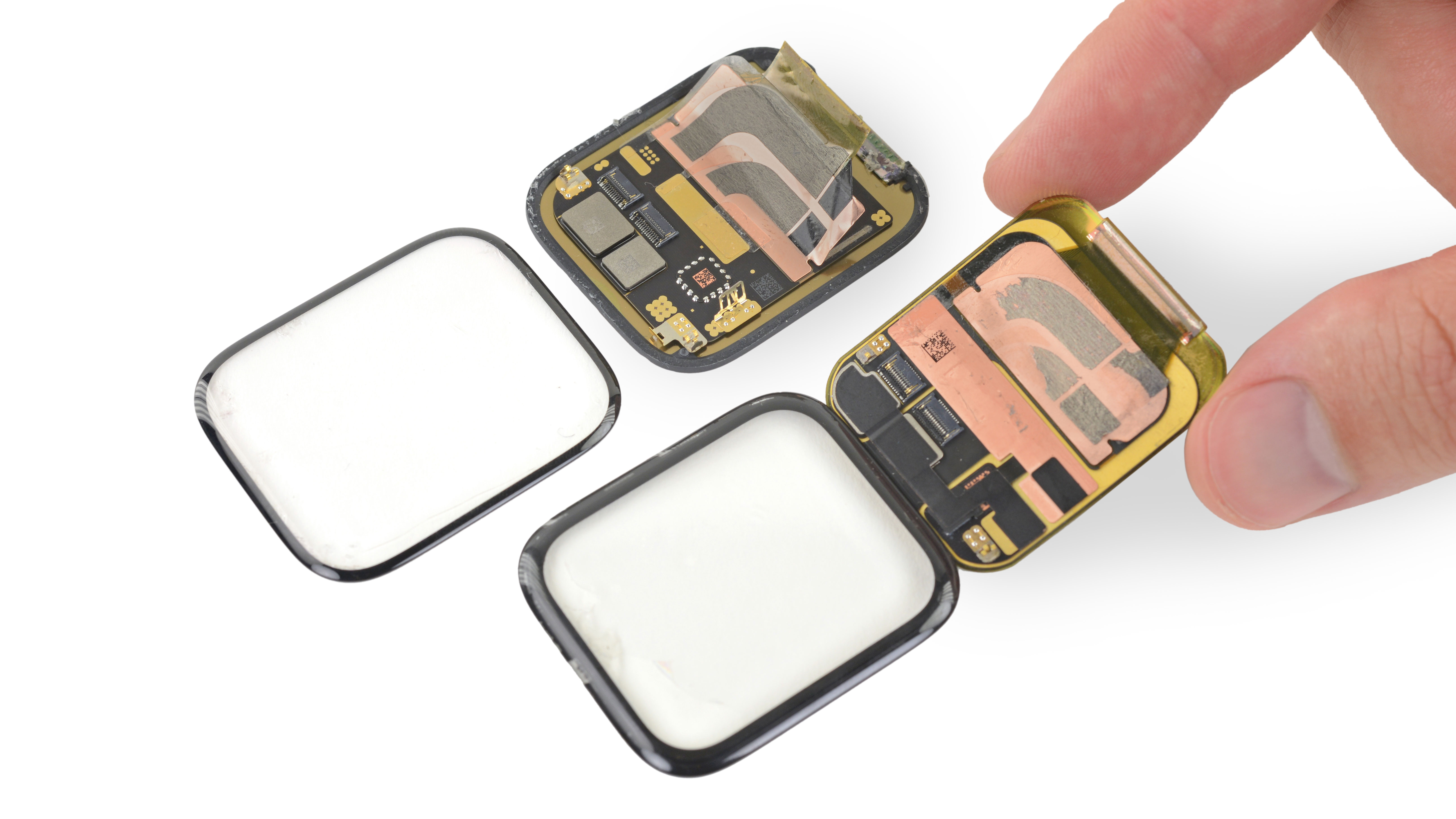
Halving the number of flexes for the display is not a trivial change. Somehow they’ve consolidated the touch signals (which used to be at the top) into the existing OLED display flex cable down at the bottom.
In short: It appears this display uses a touch-integrated OLED panel, a.k.a. “on-cell touch,” as introduced in this year’s iPhone 13 lineup. And that’s a bit of an anomaly—historically, the lower-production-volume watch gets new display technology first (OLED, LTPO, always-on, variable refresh rate), while the massively popular iPhone might eventually pick those things up. This time it’s the other way around, even if only by a few weeks.
This brings us to the dreaded D-word: DELAY. Apple announced the Apple Watch Series 7 in September without a release date, saying only that it would arrive “later this fall.” Even though the wait proved to be short, our friends at Instrumental suggested this signals production delays—and a missed target release date. The most likely culprit, by far, is manufacturing hiccups with this new display; screens have some of the most complex supply chains and assembly processes in the industry. The introduction of this new technology, combined with pushing the limits of the border design, likely caused delays in shipping the Series 7 to market.
Batteries

While battery life remains officially unchanged at “up to 18 hours,” that doesn’t mean there’s nothing to report—we found undisclosed changes here, too.
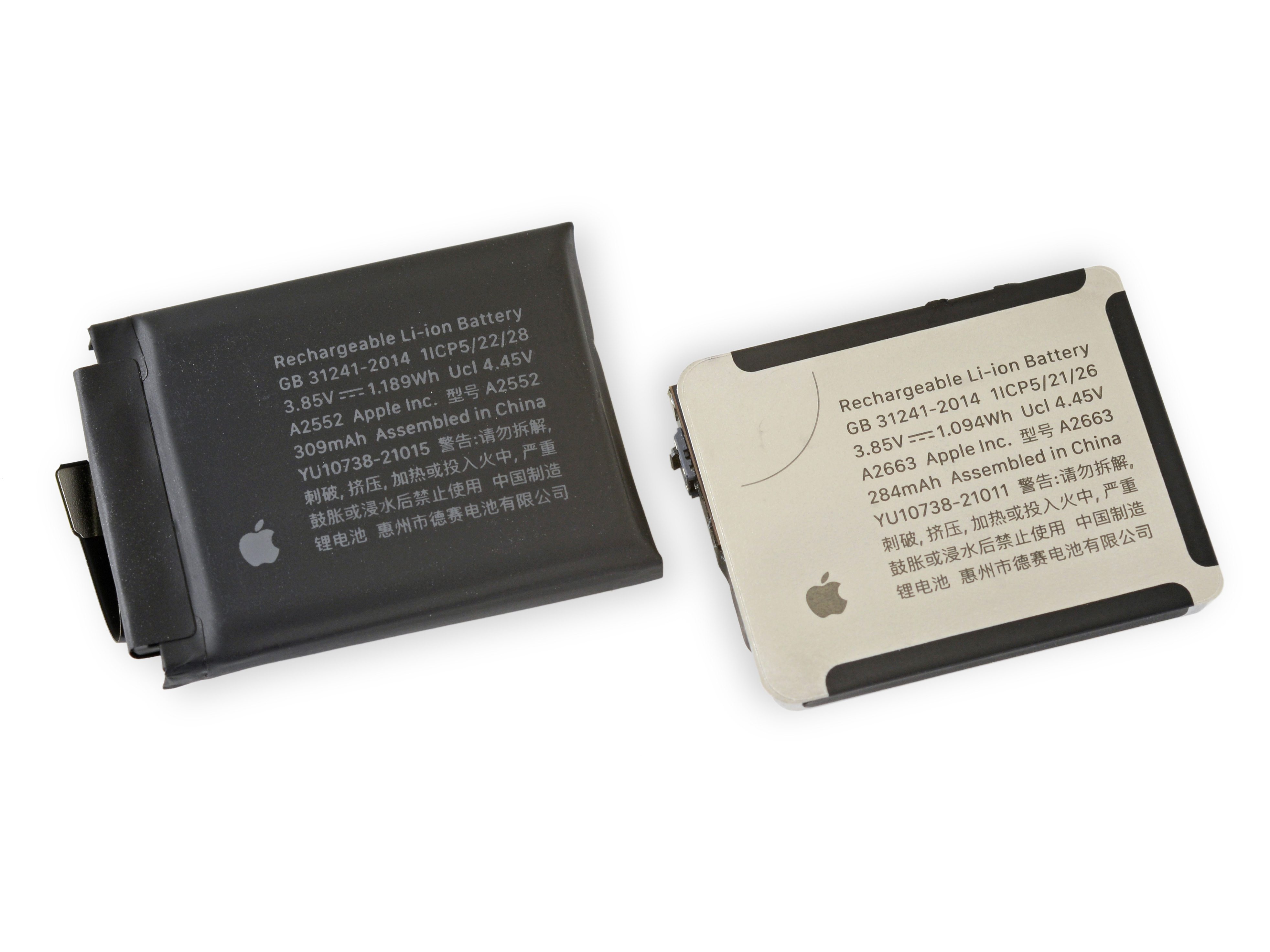

In both 41 and 45 mm form factors, we found batteries with slightly wider dimensions than last year, with slightly higher capacity and energy density. That said, those new larger, brighter displays are likely a bit power hungry, so this translates to a net-zero gain in overall battery life. Both batteries retain the same max voltage and average voltage as prior models, so there’s likely no chemistry change to the cells themselves.
The exact specs break down like so:
- 40 mm S6: 1.024 Wh
- 41 mm S7: 1.094 Wh (6.8% increase)
- 44 mm S6: 1.17 Wh
- 45 mm S7: 1.189 Wh (1.6% increase)
In other news, the smaller model still gets that radical metal battery pouch design that we first found two years ago, in the Series 5. But why is it still exclusive to the smaller model? We can think of several possibilities, but it’s likely Apple wanted to pack more energy into the same volume, so as to maximize battery life—but could only justify the cost of implementation on the smaller model, where it’s needed most.
Of Dust and Speaker Design
Past the screen and battery, the changes are small, but impactful. Pulling the Taptic Engine and speakers out requires less fiddling with tiny brackets; it seems like Apple took some time to re-think the way everything fits together. The streamlined design is appreciated in the repair world.
One other “new” feature: IP6X dust protection. Marques says in his review that the dust resistance isn’t a new design or coating, just that Apple didn’t test for it before S7. In general, that tracks—the watch was already water-resistant to a depth of 50 meters, and that’s orders of magnitude more difficult to pull off than dust sealing. (Water resistance is what drives the design, and requires the harshest tests.)

That said, if there are any signs of sneaky new ingress-protection measures, we’re determined to find them. And the mesh covering the speaker grille caught our eye. At first glance, the Series 6 speaker may look dust-proofier with its finer mesh—but on closer inspection it seems that was just an additional cosmetic mesh layer that was eliminated in the Series 7, probably to simplify the design.
Any Port in a Storm
Next out: the S7 package, which doesn’t house a brand-new processor this year, but might have something else interesting inside.

One of the surprising external changes to this year’s watch is the removal of the diagnostic port hidden in the watch band groove. Rumor has it, there’s a new 60 GHz wireless module—probably inside this S7 package—that, together with a proprietary dock, allows Apple to do the same diagnostics without a physical port.
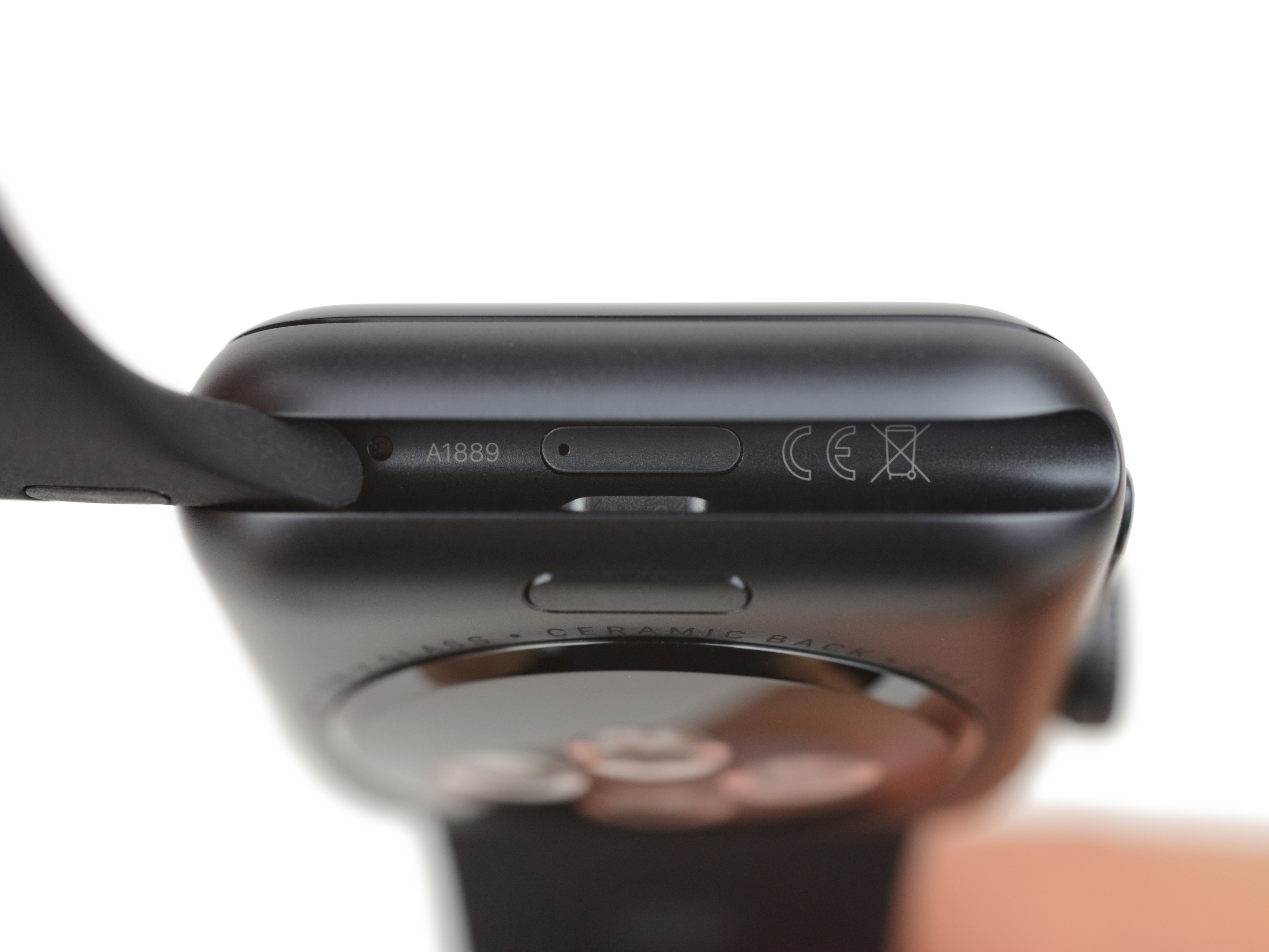
To quote our cohorts at Instrumental: we’re shocked! That port was critical for testing and loading software during assembly, as well as debugging failed devices. (Not that it ever helped third-party repair techs, who remain locked out of Apple’s software.)
So why remove it? It’s one fewer point of ingress to worry about, so removing it is a win, IPX-wise. It also simplifies assembly and saves a little space internally. And, though we truly don’t like to think about it, this could also serve as a test for a future port-less iPhone.


Repairability
In the wake of the iPhone’s disappointing slide into less-repairable waters, we decided to test the viability of some common Watch repairs before rendering a verdict on the Series 7. Good news: Display and Taptic Engine swaps on our 45 mm model worked great. All features, including automatic display brightness, remained functional with replacement parts from a second watch.
Battery replacements were equally fruitful. Even better, watchOS was able to report the “health” of the new battery—something you no longer get in an “unauthorized” iPhone battery swap. To top it off, the battery we scavenged from our Series 6 worked perfectly in the Series 7 as well—not exactly recommended, but nice to know it works in a pinch!
Intergenerational parts compatibility is obviously great for parts availability, but it also reduces manufacturing waste. And manufacturing waste is an $8 trillion problem that our friends at Instrumental spend a lot of time solving (when they’re not helping us poke around a teardown). Their platform aims to reduce waste across the supply chain, from mistakes and experiments to rework and field failures. In their own words, “Instrumental’s platform helps engineers avoid common manufacturing issues—so they can spend more time innovating and creating sustainable designs.” We’re grateful they took a time-out to help us with today’s teardown.
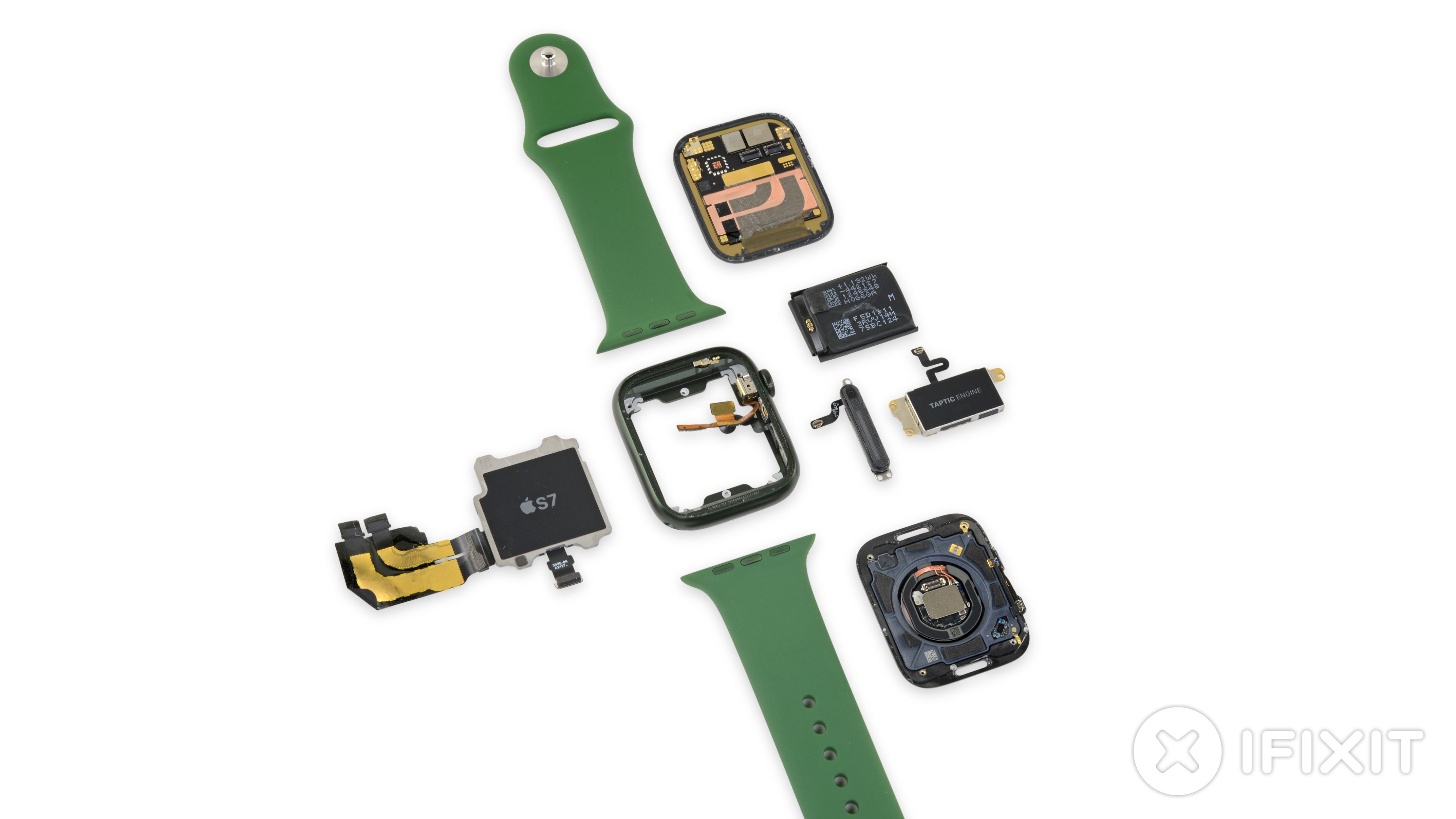
Final Thoughts
The Apple Watch Series 7 earns a 6 out of 10 on the iFixit repairability scale, for its modular construction and straightforward access to the screen and battery. It’s also nice to see the bands are still swappable and backward-compatible all the way back to the original Series 0. Improvements? We’d suggest a free public service manual, OEM replacement parts at a fair price, and maybe a screen that doesn’t have to be unglued and re-glued during every repair attempt.
If you haven’t yet, be sure to watch our extended interview with Tobias from Instrumental for some additional insider tidbits from his time at Apple. Huge thanks again to him and the entire team from Instrumental for teaming up with us on the Series 7 teardown. If you want to learn more about them and their impressive mission, we’ve got you covered:




4 Comments
Does Apple Pay still work on the series 7 after replacing the display? On former models replacing the display with one from another unit it disabled Apple Pay from being activated / used. Even when swapping genuine displays between watches.
Martin - Reply
I saw that same display technology in the new Oppo phone. It is very interesting, no more dedicated connection to the touch display…could open a lot of new possibilities in design of a whole host of products… Love the info guys. Nice work!
gregkramer - Reply
If the new apple watch series 8 coming out next year includes a microLED display and red led’s for the heart sensor, I think battery life will improve and the heart sensor will be a lot more accurate, every year Apple makes great design changes, kudos
Wes Brake - Reply
Does Apple Pay still work on the series 7 after replacing the display?
gunners S.D - Reply